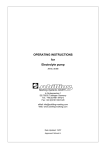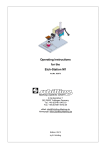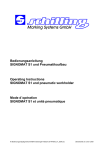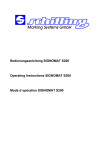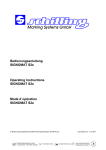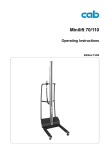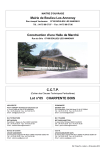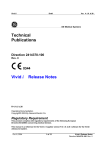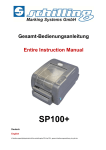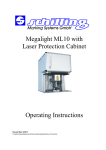Download Operating instructions SIGNOMAT S2000 and pneumatic workholder
Transcript
Marking Systems GmbH Operating instructions SIGNOMAT S2000 and pneumatic workholder Schilling Marking Systems GmbH In Grubenaecker 1 D-78532 Tuttlingen-Germany Tel. +49 (0)7461 9472-0 [email protected] www.schilling-marking.de Operating instructions for SIGNOMAT S2000 and pneumatic workholder 2 A INTRODUCTION Dear Customer, You have made a good choice by purchasing a Signomat S2000 Marking System. Thank you for your trust in our product. Your system will honour this trust, but there will be one condition to satisfy right from the onset: The system should always be treated with respect, even under the most ardent of conditions. Consequently Operating Instructions should be kept with operators. It would be a mistake to have these Operating Instructions rot away under heaps of dust. We have therefore endeavoured to give you all the recommendations and information necessary for operating, servicing and monitoring your system. Please read these Instructions carefully PRIOR TO COMMISSIONING the system in order to become familiar with them. Following these Instructions precisely will save you time and prevent losses, and you will still be fully satisfied with the system’s performance in years to come. We wish you success in your work and optimum results by employing your SCHILLING System. Thank you for your attention and have a good start! Schilling Marking Systems GmbH In Grubenäcker 1 DE-78532 Tuttlingen +49 (0)7461 9472-0 +49 (0)7461 9472-20 www.schilling-marking.de [email protected] Operating instructions for SIGNOMAT S2000 and pneumatic workholder 3 B Contents A INTRODUCTION ________________________________________________ 2 B Contents ______________________________________________________ 3 C Safety instructions______________________________________________ 4 D Scope of applications ___________________________________________ 4 E Specifications__________________________________________________ 4 F Manufacturer information ________________________________________ 4 F.1 Alterations ____________________________________________________ 5 F.2 Confidentiality _________________________________________________ 5 G Transport, installation and start up: _______________________________ 5 H Machine, pneumatic workholder and control elements________________ 6 I Working with the Signomat S2000 _________________________________ 7 J Working with the accessory equipment ____________________________ 8 J.1 Connecting cables ______________________________________________ 8 J.2 Connecting the electrolyte hose __________________________________ 8 J.3 Positioning the workpiece and stencil _____________________________ 8 J.4 Electrolyte flow ________________________________________________ 8 J.5 Regulating contact pressure _____________________________________ 8 J.6 Trial operation _________________________________________________ 9 J.7 End of marking procedure _______________________________________ 9 J.8 Improving marking results _______________________________________ 9 J.9 Short circuits __________________________________________________ 9 J.10 Servicing and maintenance ______________________________________ 9 K Use of Electrolytes_____________________________________________ 11 L Ordering carbon stamps and stencils _____________________________ 13 M Appendix_____________________________________________________ 14 Schilling Marking Systems GmbH In Grubenäcker 1 DE-78532 Tuttlingen +49 (0)7461 9472-0 +49 (0)7461 9472-20 www.schilling-marking.de [email protected] Operating instructions for SIGNOMAT S2000 and pneumatic workholder 4 C Safety instructions When used properly, the SIGNOMAT S2000 is opertionally safe. Still, a few points should be noted for the handling of chemicals: Use rubber gloves. Eyes must be protected against electrolyte, neutralyte and preserving agent. Should eyes come into contact with the chemicals, immediately rinse eyes thoroughly with clear water and contact a physician. Do not swallow electrolyte, neutralyte and preserving agent. Should electrolyte be swallowed, immediately drink a large glass of clear water and contact a physician. Should skin or clothing come into contact with the chemicals, rinse immediately with water. Eating or drinking at the workplace is prohibited. Hands must be washed before eating. Electrolyte may be disposed of in the normal sewage system. Keep children clear of the machine. Use the Signomat S2000 in dry locations only. Ensure correct mains voltage (230 volts or 115 volts, see nameplate). Keep explosive gases clear of the machine. Disconnect the mains plug before opening the machine. Most points at which danger of injury exist have been eliminated. However, please take care to keep hands away from the pneumatic workholder during the working and return strokes. Never short-circuit the sockets by connecting two sockets by a cable. The overcurrent circuit breaker responds, but the machine may still be damaged under certain conditions. D Scope of applications The equipment is designed exclusively for marking metallic objects. Proper function and a reproducible result is garanteed only when Schilling accessories are used. E Specifications Type: Serial Number: Year of manufacturing: Dimensions: WxLxH Operating voltage: Marking voltage: Type of mark: Rate power: Weight: Fuse: Noise level: Type: Factory number: Year of manufacturing: Dimensions without electrolyte bottle: WxLxH Weight: Vertical stroke of stamp: Air consumtion per stamping procedure: Range of opt. working pressure: Max. operating pressure: SIGNOMAT S2000 see nameplate see nameplate 362 x 150 x 315 mm 115/230 V 50/60 Hz 12 V/18V/24V light/dark 300 VA 12,5 kg 2 AT 20 dB Pneumatic workholder see nameplate see nameplate 260 x 380 x 532 mm approx. 12 kg 50 mm 0.075 l 2.5 - 3 bar 6 bar F Manufacturer information Schilling Marking Systems GmbH In Grubenaecker 1 DE-78532 Tuttlingen-Germany Telephone: +49 (0)7461 9472-0 Fax: +49 (0)7461 9472-20 eMail: [email protected] URL: www.schilling-marking.com Schilling Marking Systems GmbH In Grubenäcker 1 DE-78532 Tuttlingen +49 (0)7461 9472-0 +49 (0)7461 9472-20 www.schilling-marking.de [email protected] Operating instructions for SIGNOMAT S2000 and pneumatic workholder 5 F.1 Alterations Technical alterations reserved. Your machine may therefor deviate in details from the illustrations in the manual. This does not affect the operation of the machine. F.2 Confidentiality These operating instructions are to treated confidentially. They have been provided only for use in your operation by authorized persons. The transfer of this document to third parties is prohibited and results in damage claims. All rights, including the right to translation, are reserved. G Transport, installation and start up: Please keep the packaging for re-use during transport. Ensure that all accessories are packed, too and that bottles of chemicals are well sealed. Should chemicals run out, wipe up by using rubber gloves, cleaning rags and water. See safety recommendations in Chapter A. Check whether your mains voltage corresponds with the voltage stated on the rating plate. Connect the Signomat by the mains cable 15 to a mains socket. Connect the carbon stamp (9 or 50) to the black cable 21 and to the black socket of the system. Then connect the red cable 20 to the red socket 13 and to the red fixture 59 or the red socket on the contact plate. Check whether the hand stamp 9 is equipped with a felt and O-Ring 17. Then wet the felt with a little electrolyte. Schilling Marking Systems GmbH In Grubenäcker 1 DE-78532 Tuttlingen +49 (0)7461 9472-0 +49 (0)7461 9472-20 www.schilling-marking.de [email protected] Operating instructions for SIGNOMAT S2000 and pneumatic workholder 6 H Machine, pneumatic workholder and control elements 9 10 12 14 15 17 20 21 24 25 26 27 28 29 30 31 32 33 34 35 36 37 38 39 40 41 42 43 44 45 46 47 48 49 50 51 52 53 54 55 56 57 58 59 60 61 62 manual stamp contact clamp Y1 connecting cable from Y1 contact socket 11 of the Signomat to the pneumatic workholder (without electrolyt pump) foot switch with cable and plug mains cable felt piece and O-Ring red cable black cable locking screw, workpiece pick-up for transfer adjustment (x-axis) knurled screw, workpiece pick-up for longitudinal adjustment (y-axis) knurled screw, workpiece pick-up for horizontal rotation adjustment knurled screw for stop knurled screw for stencil holder spring knurled nuts for longitudinal stencil adjustment (y-axis) knurled nuts for transverse stencil adjustment (x-axis) knurled screw for stencil height (z-axis) knurled screw for horizontal rotation adjustment of stamp lever for height adjustment of marking arm electrolyte pump (special accessories, item no. 35.005. For maintenance and adjustment, see separate pump instructions) socket for Y1 connecting cable 37 socket for connecting cable 55 Y1 connecting cable from pump case (socket 35) to Y1 contact socket 12 of the Signomat pump: supply pumps, automatic metering of electrolyte pump: fast supply pump: fast return controller for amount to be metered electrolyte hose (pump), item no.35.220 pump wheel clamp pressure reducing valve with manometer oiler regulating screw on oiler condensate delivery screw magnetic valve stamp felt piece workpiece pick-up marking stencil O-ring connecting cable from pump case (socket 36 to magnetic valve 49) socket on magnetic valve for cable 55 manual injector (electrolyte hose: item no.34.274) compressed air hose for connection to a compressor air line marking head bottle, item no.35.813 hollow needle, item no.35.810 felt case for automatic felt transport (accessory equipment; requires compressed air connection, item no.11.130 Schilling Marking Systems GmbH In Grubenäcker 1 DE-78532 Tuttlingen +49 (0)7461 9472-0 +49 (0)7461 9472-20 www.schilling-marking.de [email protected] Operating instructions for SIGNOMAT S2000 and pneumatic workholder 7 I Working with the Signomat S2000 Smaller workpieces can be placed directly on contact plate. Select the correct electrolyte for the metal of the workpiece according to the provided table, and the recommended marking time. Carefully and evenly moisten the felt piece on the stamp and the stencil with the selected electrolyte. The felt must be evenly moistened with the electrolyte and should not drip. Position the moistened marking stencil with the desired text on the workpiece. Press the manual stamp downward vertically, ensuring that the entire surface contacts the stencil evenly. If foot switch 14 is not used, the marking current is now automatically switched on. If foot switch 14 is used and connected to socket 13, marking current is switched on only after the stamp has made contact with the workpiece and foot switch 14 has been activated. Wipe away remaining electrolyte using a cloth moistened with neutralyte. Metals which corrode are neutralised by neutralyte N2 and protected by preserving agent K1. The electrolyte suitable for the workpiece material used is listed in the provided table. In order to avoid oxidation (rust), we urgently recommend that chemicals are handled with extreme care. Above all, never touch the workpiece with your hands when traces of electrolyte are on your hands (electrolyte may be carried over). For steel with high carbon content, thorough neutralization, cleaning by ultrasound and/or coating with a film of oil or a preserving agent is highly recommended. To avoid corrosion we are keeping Electrolytes with less corrosion as an alternative! Schilling Marking Systems GmbH In Grubenäcker 1 DE-78532 Tuttlingen +49 (0)7461 9472-0 +49 (0)7461 9472-20 www.schilling-marking.de [email protected] Operating instructions for SIGNOMAT S2000 and pneumatic workholder 8 J Working with the accessory equipment Contact clamp 10 is provided for marking bulky objects. Clamp the contact clamp onto the workpiece, connect the red cable to the contact clamp and red socket 13, and mark the workpiece using stencil and manual stamp as described above. Add-on assemblies constructed according to customer specification are additionally available as accessory equipment, and facilitate exact marking by holding the stencil and workpiece in a precisely defined position. Place the workpiece in the workpiece pick-up (exchangeable and constructed according to customer specification on request) of the add-on assembly and adjust the stencil using the adjusting screw. Connect the workpiece pick-up on the add-on assembly to the red socket 13 using the red cable, and mark the workpiece using the manual stamp as described above. J.1 Connecting cables The red cable is connected to marking head 59; the black cable is connected to stamp 50. Connect electrolyte pump 34 (accessory equipment) to socket 35 by means of the provided cable 37, and to the Signomat (socket 12). Insert cable 55 in socket 36, and connect to socket 56 on magnetic valve 49. J.2 Connecting the electrolyte hose Please observe the safety instructions provided section C when handling chemicals. If the hose is already connected to the bottle containing electrolyte, the hose must first be removed again from the bottle. The hose should contain no liquid when it is installed in the pump. Set the distance between pump block and pump wheel as described in the separate operating instructions of the electrolyte pump and using the provided setting ring gauge. Switch on the Signomat and pump 34 by means of switch 39 (>>supply). Now insert the electrolyte hose into the guide of pump wheel 43 from the left and pull through to the right. Ensure that the length of the hose is sufficient for the movement of the stamp to workpiece pick-up 52. The electrolyte hose should be not pulled too tight. Connect the left-hand end of the hose to electrolyte bottle 60 (containing with hollow needle 61). Caution: the bottle has an air hole through which electrolyte can escape - do not tilt bottle! Connect the right-hand end of the hose to the stamp. J.3 Positioning the workpiece and stencil Position felt piece 51 on the stamp from the bottom, and secure using black O-ring 54. Workpiece pick-up 52 is positioned with the workpiece transversely to the stamp by means of locking srew 24. Knurled screw 25 is provided for longitudinal adjustment of the workpiece pick-up. The stop is set by means of knurled screw 27. Loosen knurled screw 28, insert marking stencil and clamp by means of the holding spring at knurled screw 28. The stencil can be positioned exactly by means of the knurled screws and knurled nuts 29, 30 and 31 by loosening the locking screws and setting the turning screws. Stamp 50 can be set at a turned angle by means of knurled srew 32. The height of the marking arm, and thus the stroke of the stamp can be set by means of lever 33 located at the rear of the machine. The stamp covers a maximum stroke of 50 mm. The lenght of the stroke does not influence the quality of the resulting mark, but the marking procedure can be shortened by setting as short a stroke as possible. Exact positioning of workpiece pick-up 52, stamp 50 and marking stencil 53 can be checked without exerting pressure by pulling down the stamp when the machine is switched off. J.4 Electrolyte flow Electrolyte is transported to the felt piece by means of the electrolyte pump (automatic supply) or the manual injector (manual supply), depending on the construction on the pneumatic workholder. Automatic supply: Activate switch 39 (>>supply) and wait until the electrolyte has reached the stamp. Then activate switch 38 (>operation) and set the required flow rate by means of controller 41 located on the the righthand side of the pump. The flow-rate should be sufficient to keep the felt piece on the stamp continuousely moistened, but not so great that electrolyte is pressed out of the felt piece during the marking procedure (2-3 bar is recommended). After operating the foot switch on the control unit, the electrolyte pump automatically provides the set electrolyte flow rate for the marking procedure. Manual supply: Fill manual injector 57 with electrolyte, connect the electrolyte hose and insert the injector in the mount on the front of the marking arm. Metering must be carried out manually at regular intervals. J.5 Regulating contact pressure Pressure reducing valve 45 with manometer is located on the left-hand side of the pneumatic workholder. The valve is disengaged by pulling upward; pressure can then be regulated. Look the valve again after this has been done by pressing downward. Next to the valve, oiler 46 is located which supplies the compressed air with oil for the Schilling Marking Systems GmbH In Grubenäcker 1 DE-78532 Tuttlingen +49 (0)7461 9472-0 +49 (0)7461 9472-20 www.schilling-marking.de [email protected] Operating instructions for SIGNOMAT S2000 and pneumatic workholder 9 stroke cylinder. Ensure that the oiler has a sufficient supply of machine oil at all times. Good results are attained at contact pressures between 2 - 4 bar. Pressure must be set higher for marking larger surfaces. Excessive pressure (6 bar) presses the electrolyte out of the felt piece. The resulting mark is not acceptable. J.6 Trial operation Position the workpiece and check the settings. When the Signomat is ready for operation, set marking time and type of marking as described in the corresponding paragraphs. Activate the foot switch connected the Signomat and start a trial marking procedure. If the result meets your requirements, serial production can be started. If this is not the case, change the settings as required or check wheather the tips given in the section „improving marking results“ would be of help. J.7 End of marking procedure When switch 40 (<<return) of the electrolyte pump is activated, the electrolyte remaining in the electrolyte hose and felt piece is pumped back into the container. Switch off machine. Remove felt piece 51 from stamp 50 and rinse both thoroughly with water. If work is to be interrupted for several days, rinse the electrolyte hose with water. J.8 Improving marking results Before the first marking procedure, moisten the stencil with electrolyte when current is switched off. Dry felt impedes current conduction, and the resulting mark is extremely poor. Dried electrolyte and neutralyte result in salt deposits in the machine; this also impedes current conduction, causing poor marking results. For this reason, daily rinsing with claer water is necessary. Stencils soiled by metallic residue must be cleaned carefully and at regular intervals. To do this, hold the stencil carefully between two fingers under water and clean. The stamp and workpiece pick-up must also be cleaned with water at regular intervals. In case of extreme soiling, clean with Schilling Schleifreiniger (abrasive cleaner; item n.22.165). Ensure that the electrolyte suited for the metal to be marked is on hand. Certain materials, e.g. hard metal, must be protected by preserving agent K1 (item no.22.112). Mark small surfaces using the simple pressing method. Mark larger surfaces manually using the stroking method. A working pressure of 2 - 4 bar in the pneumatic workholder provides good results. Use higher pressures only for larger marking images. To avoid premature wear and to prevent the electrolyte from evaporating, the stencil should not be heated excessively. The material of the stencil heats up to a temperature of more than 120°C. This causes poor marking results. The stencil must than be replaced. In normal operation, the stencils with long service life are good for 2000-3000 marking procedures. Felt which has darkened must be replaced in regular intervals. Bigger marking images cause stronger and faster darkening or pollution of the felt. J.9 Short circuits The main fuse is at the rear of the controller. Remove the black cover to withdraw the blown fuse and replace it by the spare fuse supplied. Should the fuse be OK, check mains connection. Should no marking power be available, check whether the cables are kinked and therefore interrupted. If so, immediately replace cables with original Schilling replacement cables. J.10 Servicing and maintenance Signomat: The Signomat is maintenance-free. The stamp, the felt piece and contact plate 16 or workpiece pick-up 52 must be cleaned thoroughly with water after each working day. Stencils have a service life of 2000-3000 marking procedures. Replace the stamp when it shows signs of excessive wear. Replace the stamp when it shows signs of excessive wear. Replace darkened felt pieces. The ordering numbers are provided on the following pages. Pneumatic workholder: Clean stamp, felt piece and workpiece pick-up thoroughly with water after each working day. This is essential. Replace worn electrolyte hoses. Ensure that oiler 46 (next to the pressure reducing valve) is always filled with a sufficient level of acid-free machine oil. Oil flow is regulated by means of the screw mounted on the oiler. Clean the rollers of pump wheel 43 and oil with resin-free oil. Schilling Marking Systems GmbH In Grubenäcker 1 DE-78532 Tuttlingen +49 (0)7461 9472-0 +49 (0)7461 9472-20 www.schilling-marking.de [email protected] Operating instructions for SIGNOMAT S2000 and pneumatic workholder 10 36 35 34 37 45 33 55 49 56 29 58 32 30 57 31 54 51 24 28 53 50 52 52 26 27 25 59 33 45 47 61 60 62 46 48 39 38 40 42 43 34 41 44 Schilling Marking Systems GmbH In Grubenäcker 1 DE-78532 Tuttlingen +49 (0)7461 9472-0 +49 (0)7461 9472-20 www.schilling-marking.de [email protected] Operating instructions for SIGNOMAT S2000 and pneumatic workholder 11 K Use of Electrolytes ItemNo Electrolyte Material, alloys, branch Power unit setting/ voltage All data have been determined by experiment and are not applicable in general. A special hotline has been provided for our customers. Notes Aluminium 22.038 AE38 light/24V Aluminium (most alloys) 22.002 AE2 light/24V Allow a few seconds for color to develop before cleaning AE25 light/24V Black not possible unless lacquer filled AE12 AE1 AE26 AE30 AE26 AE37 AE25 AE37 AE25 AE21 AE5 AE5 AE35 AE5 AE24 AE37 AE37 AE25 AE37 AE25 AE30 AE37 AE25 AE30 AE10 AE21 AE37 AE1 AE37 AE30 AE35 AE36 AE30 AE12 AE21 AE1 AE30 AE21 AE3 AE24 AE30 AE37 AE25 AE21 AE1 AE24 AE35 AE36 AE35 AE36 light/24V dark/12V dark/12V dark/12V dark/12V dark/12V dark/12V dark/12V dark/12V dark/12V dark/12V dark/12V dark/12V dark/12V dark/12V dark/12V dark/12V dark/12V dark/12V dark/12V dark/12V dark/12V dark/12V dark/12V dark/12V dark/12V dark/12V dark/12V dark/12V dark/12V dark/12V dark/12V dark/12V dark/12V dark/12V dark/12V dark/12V dark/12V dark/12V dark/12V dark/12V dark/12V dark/12V dark/12V dark/12V dark/12V dark/12V dark/12V dark/12V dark/12V Deep etch BEFORE anodizing (minimum 0.05mm) Aluminium with high magnesium or silica 22.025 content 22.012 Beryllium 22.001 Black oxide 22.026 22.030 Black oxide steels 22.026 Brass 22.037 22.025 Bronze 22.037 22.025 Carbides 22.021 Chrome plate 22.005 Chrome plate (decorative) 22.005 22.035 Chrome plated parts 22.005 22.024 Cobalt alloys 22.037 Copper 22.037 22.025 Copper alloys 22.037 22.025 Copper nickel 22.030 CuZn alloys 22.037 22.025 Discaloy 22.030 Gold & gold plate 22.010 22.021 Hastelloy 22.037 Haynes 25 22.001 Inconnel 22.037 Inconnel 718 & 750 22.030 Iron 22.035 22.036 Lead & alloys 22.030 Monel 22.012 22.021 Nickel & alloys 22.001 22.030 Nickel plate (brass & copper) 22.021 Nickel, chemical 22.003 Nickel plate (steel & alu) 22.024 22.030 Nickel silver 22.037 22.025 Nitraloy 22.021 Steels, stainless 22.001 22.024 22.035 22.036 Steels, decorative (advertising material) 22.035 22.036 Schilling Marking Systems GmbH In Grubenäcker 1 DE-78532 Tuttlingen +49 (0)7461 9472-0 Current setting: light & dark Current setting: light & dark Current setting: light & dark pH-neutral, low corrosion pH-neutral, low corrosion pH-neutral, low corrosion pH-neutral, low corrosion pH-neutral, low corrosion pH-neutral, low corrosion pH-neutral, low corrosion +49 (0)7461 9472-20 www.schilling-marking.de [email protected] Steels, food & nutrition industry Steels, surgical instruments ItemNo Electrolyte Material, alloys, branch Power unit setting/ voltage Operating instructions for SIGNOMAT S2000 and pneumatic workholder 12 Notes AE7 AE33 AE34 AE33 AE21 AE20 AE35 AE36 AE1 AE33 AE35 AE10 AE12 AE10 dark/12V dark/12V dark/12V dark/12V dark/12V dark/12V dark/12V dark/12V dark/12V dark/12V dark/12V dark/12V dark/12V dark/12V pH-neutral, low corrosion pH-neutral, low corrosion Tin 22.007 22.033 22.034 22.033 22.021 22.020 22.035 22.036 22.001 22.033 22.035 22.010 22.012 22.010 Titanium 22.037 AE37 dark/12V Use minimum Electrolyte and short marking times (1-1,5s) 22.028 22.033 22.010 22.033 22.035 22.028 22.026 22.010 22.021 22.028 AE28 AE33 AE10 AE33 AE35 AE28 AE26 AE10 AE21 AE28 dark/12V dark/12V dark/12V dark/12V dark/12V dark/12V dark/12V dark/12V dark/12V dark/12V Steels, tool & high alloy Steels, hardened & unhardened Steels, corrosive Steels, until 1.4021 / 1.4310 Steels, CrCo, steels from 1.4310 Steels, low carbon Tool steel Tool steel, high alloy & harden able Tungsten (pure) Tungsten carbide Zinc & zinc plate Zirconium Schilling Marking Systems GmbH In Grubenäcker 1 DE-78532 Tuttlingen +49 (0)7461 9472-0 pH-neutral, low corrosion pH-neutral, low corrosion pH-neutral, low corrosion pH-neutral, low corrosion pH-neutral, low corrosion pH-neutral, low corrosion pH-neutral, low corrosion pH-neutral, low corrosion Without neutralisation/cleaning Without neutralisation/cleaning +49 (0)7461 9472-20 www.schilling-marking.de [email protected] Operating instructions for SIGNOMAT S2000 and pneumatic workholder 13 L Ordering carbon stamps and stencils Manual stamps and stamps Select the manual stamp or machine stamp and note the first two numbers; these are the first two digits of the ordering number. Use the table provided below to determine the dimensions of the stamp; select a stamp shape from A to I and complete the ordering number. Please specify the desired diameter for stamp shapes B, C, E, F, G and H. Example: 34.806 C 8 = machine stamp/dimensions 50x15x25 mm/shape C/concave for 8 mm diameter. Manual stamp 29. 34. Machine stamp B C H H D D B concave E H L B flat D B L convex H H I 1 2 3 4 convex .800 .801 .811 .802 .803 .804 15 20 25 30 35 40 .805 .806 .807 .808 .809 .810 45 50 55 60 80 100 Other dimensions available on request. Manual stamp with integrated electrolyte supply, not pictured. Ordering no. 29.001 Automatic felt piece adjustment without stamp, not pictured. Ordering no. 11.130 Manual felt piece adjustment without stamp, not pictured. Ordering no. 11.120 ofset < 15 x 15 15 biconcave Stencils: Width 15mm L B H H H concave F H H G L B flat Height 25mm Ordering no. Lenght in mm Ordering no. Lenght in mm H L B Standard dimensions 7.5 A 15 Price for repros X € Price for photosetting, one line Y € ( several lines available on request ) Price for marking stencil Z € Price for subsequent orders Z € Standard stencils 65 mm 39,5 +/- 1 mm 3 2 4 Föhrenstr. 47 D-78532 Tuttlingen Tel.: 07461/9472-0 15 mm 1 Ordering no. FO 40 FO 50 FO 60 FO 80 FO 100 b 30 40 50 70 90 Stamp size (dimensions in mm) < 30 < 40 < 50 < 70 < 90 Stencil with short service life 123456 Ordering no. b 22.160 22.161 22.162 22.163 22.162.1 c a 40 50 60 80 100 Dimensions BS 60x180mm BL 60mm x 10m BS 60mm x 25m 230 x 330mm 76mm x 30m perforated Special stencils with special frames available on request Schilling Marking Systems GmbH In Grubenäcker 1 DE-78532 Tuttlingen +49 (0)7461 9472-0 +49 (0)7461 9472-20 www.schilling-marking.de [email protected] Operating instructions for SIGNOMAT S2000 and pneumatic workholder 14 M Appendix On the following pages of the revised Signomat S2000 Operating Instructions we have endeavoured to make your work as easy as possible. There is no need to read text any longer and the captions to the figures will allow you to learn how to operate the controller in a jiffy. We wish you every success and a fast start! Schilling Marking Systems GmbH In Grubenäcker 1 DE-78532 Tuttlingen +49 (0)7461 9472-0 +49 (0)7461 9472-20 www.schilling-marking.de [email protected] Operating instructions for SIGNOMAT S2000 and pneumatic workholder 15 Programming of controller SIGNOMAT S2000 please refer to separate manual Schilling Marking Systems GmbH In Grubenäcker 1 DE-78532 Tuttlingen +49 (0)7461 9472-0 +49 (0)7461 9472-20 www.schilling-marking.de [email protected]















